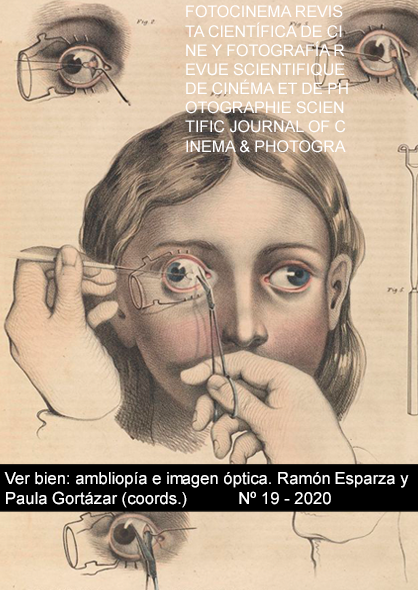Photography’s failure: an intermedial response to the phenomenological agenda in Roland Barthes’ camera lucida
DOI:
https://doi.org/10.24310/Fotocinema.2019.v2i19.6652Keywords:
Photography, Phenomenology, Intermediality, Philosophy, Camera Lucida, Roland Barthes.Abstract
The aim of this article is to give account of the limitations of Roland Barthes theoretical proposal in order to analyze photography, in as much as this proposal is considered in the light of the phenomenological program of the French philosopher. Given the importance of Barthes's theory in the field of photography, we believe that these limitations are only perceptible if Barthes's program is read, , as we try to do in the present work, from an intermediary position, that is, analizing the relationship that photography—as a material representation of reality—presupposes and develops within its sourroundings some historical-mediatic instances that are in contradiction to the regional essences recognized by Barthes. Therefore, photography is presented as a supplement that seeks to materially fullfill reality. A supplement that, both in its constitution and its consequences, is based on a metaphysical substrate, namely, the absolute appearance or appearance as an absolute of the photographed object.
Downloads
Metrics
Publication Facts
Reviewer profiles N/A
Author statements
Indexed in
-
—
- Academic society
- N/A
- Publisher
- Universidad de Málaga
References
Asensi Pérez, M. (2006). Los años salvajes de la teoría. Philippe Sollers, Tel Quel y la Génesis del pensamiento post-estructural francés. Valencia: Tirant Lo Blanch.
Avelar, I. (2000). Alegorías de la derrota: la ficción postdictatorial y el trabajo de duelo. Santiago: Universidad de ARCIS – Escuela de Filosofía de la Universidad ARCIS.
Barthes, R. (1968). La mort de l’auteur. In Le bruissement de la langue. Essais critiques IV. París: Seuil.
Barthes, R. (1970). L’ancienne rhétorique. Aide-mémoire. In Communications, Num. 16, 172-223.
Barthes, R. (1980). La chambre claire. Note sur la photographie. París: Gallimard – Le Seuil.
Batchen, G. (2000). Each wild idea. Writing. Photography. History. Massachusetts: MIT Press.
Bourdieu, P. (1982). Qué significa hablar. Madrid: Akal.
Bourdieu, P., Boltanski, L., Castel, R., Chamborderon, J.C. & Schnapper, D. (1990). Photography. A Middle-brow Art. Translated by Shaun Whiteside. Oxford: Polity Press.
Butler, J. (2007). Torture and the ethics of photography. In Society and Space, Vol. 25, 951-966.
Cadava, E. (2011). Susurro de miradas. In Walter Benjamin. Dirección Múltiple. Editora Esther Cohen. Traducción de Paola Cortés Rocca. México: UNAM - Instituto de Investigaciones Filológicas.
Compagnon, A. (1998). Le démon de la théorie. Littérature et sens commun. Paris : Seuil.
Deleuze, G. (1986). Foucault. París: Minuit.
Déotte, J. L. (2004). La época de los aparatos. Traducción de Antonio Oviedo. Buenos Aires: Adriana Hidalgo Editora.
Derrida, J. (1967). La voix et le phénomène. Introduction au problème du signe dans la phénoménologie de Husserl. París: PUF.
Derrida, J. (1985). Des tours de Babel. In Difference in Translation. Edited with an Introduction by Joseph F. Graham. Ithaca and London: Cornell University Press.
Derrida, J. (1996). Foi et savoir suivi de Le siècle et le pardon. París: Seuil.
Elkins, J. (2011). What Photography Is. New York: Routledge.
Foucault, M. (1969). L’archéologie du savoir. París: Gallimard.
Gallop, J. (2009). The pleasure of the phototext. In Photography Degree Zero. Edited by Geoffrey Batchen. Cambridge: MIT Press.
Husserl, E. (1929). Lógica formal y lógica trascendental. Ensayo de una crítica de la razón lógica. Traducción de Luis Villoro. México: UNAM – Instituto de Investigaciones Filosóficas.
Müller, J. E. (2000). L’intermédialité, une nouvelle approche interdisciplinaire: perspectives théoriques et pratiques de la vision de la télévision. In Cinémas: révue d’études cinématographiques / Cinémas: Journal of Film Studies, Vol. 10, Num. 2-3, 105-134.
Müller, J. E. (2006). Vers l’intermédialité. Histoires, positions, options et un axe de pértinence. In Médiamorphoses, Num. 16, 2006, 99-110.
Rajewsky, I. O. (2005). Intermediality, Intertextyality, and Remediation: A Literary Perspective on Intermediality. In Intermédialités, Num. 6, Automne, 43-64.
Sánchez Vázquez, A. (2007). De la estética de la recepción a una estética de la participación. México: UNAM – Facultad de Filosofía y Letras.
Valéry, P. (1919). La crise de l’esprit. In Variété I et II. París: Gallimard – Collection Folio.
Weigel, S. (1996). Legibilidad. En Cuerpo, imagen y espacio en Walter Benjamin. Una relectura. Traducción de José Amícola. Buenos Aires: Paidós.
Downloads
Published
How to Cite
Issue
Section
License
All contents published in Fotocinema Revista científica de cine y fotografía are protected under the Creative Commons Attribution-NonCommercial-ShareAlike 4.0 International (CC BY-NC-SA 4.0) license. All about this license is available in the following link: <http://creativecommons.org/licenses/by-nc-sa/4.0>
Users can copy, use, redistribute, share and exhibit publicly as long as:
- The original source and authorship of the material are cited (Journal, Publisher and URL of the work).
- It is not used for comercial purposes.
- The existence of the license and its especifications are mentioned.
There are two sets of authors’ rights: moral and property rights. Moral rights are perpetual prerogatives, unrenounceable, not-transferable, unalienable, imprescriptible and inembargable. According to authors’ rights legislation, Fotocinema. Revista científica de cine y fotografía recognizes and respects authors moral rights, as well as the ownership of property rights, which will be transferred to University of Malaga in open access. The property rights are referred to the benefits that are gained by the use or the dissemination of works. Fotocinema. Revista científica de cine y fotografía is published in an open access form and it is exclusively licenced by any means for doing or authorising distribution, dissemination, reproduction, , adaptation, translation or arrangement of works.
Authors are responsable for obtaining the necessary permission to use copyrighted images.














13.png)



